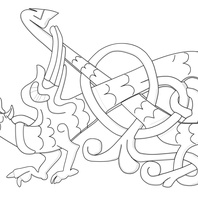
Collection
Viking Talks
A series of talks given at the University of Nottingham in 2017-2018 and made available here to watch and listen to again. All the talks are shown in the slider bar below. Many thanks to Lakeside Arts for help with organising the talks, and for recording and transcribing them.
Read More
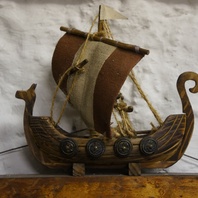
Blog Post
Bringing Vikings Back to the East Midlands
As this website is about to go live, it seems right to reflect on what has happened over the last year and a half and where we are going next. 2017 and 2018 were very busy with our ‘Bringing Vikings Back to the East Midlands’. It all started when the University Museum heard that it would be one of the venues for the British Museum travelling exhibition Viking: Rediscover the Legend. We began making some preparations for associated activities, and were lucky enough to get a substantial grant from the Arts and Humanities Research Council to support these activities. We were even luckier that Dr Roderick Dale, formerly of the World-Tree Project at University College, Cork, was available to take on the post of Cultural Engagement Officer and to manage these activities. We then started thinking bigger and planned, and got funding for, a second exhibition, Danelaw Saga, and a popular book on Viking Nottinghamshire. You can read about all of these things in more detail on our About the Project page. One important aspect of that project was to fix some of what was achieved then for the future, hence this site, which we think of as a virtual museum. Here, you will be able to catch up on some of the talks that you might have missed during the exhibitions. You will also be able to see many of the items featured in the Danelaw Saga exhibition, with more information about where to go to see them in museums, or on the Portable Antiquities scheme website. A strong feature of our exhibition-related activities were the handling sessions with museum-quality reproductions of Viking Age artefacts made especially for us by Adam Parsons of Blueaxe Reproductions – we now have high-quality photos of these for you to download and marvel at how the objects would have looked when they were new. A further exciting feature are the Viking designs made for us by Adam – these are line drawings which you can use for whatever educational or entrepreneurial purpose you might have. They are open-access and available to use under Creative Commons CC-BY-4.0. Other features of this museum, such as the place- and personal names and runes are still in development, so keep coming back to find something new. Although the original project is now officially over, Roderick is still with us for phase 2. He will keep working on this site during the coming year, alongside some other duties, so bear with us as we keep making it better and more detailed. Do explore this virtual museum and let us know what you think on our Twitter account @emidsvikings.
Read More
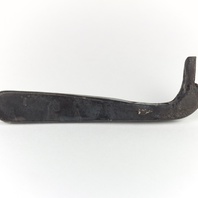
Viking Objects
Reproduction Iron Key
An iron key based on an original found in Grave 511 at Repton, Derbyshire. Iron keys were not only practical items but also symbols of status. Women were often given keys to the families chests of valuables. They also are often buried with keys, representing their authority in the household.
Read More
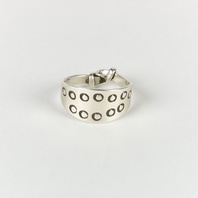
Viking Objects
Reproduction Stamped Finger Ring
A reproduction, stamped, silver ring with knotted ends. Rings with this type of stamped decoration are typical of Scandinavian design during the Viking Age.
Read More
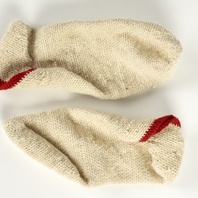
Viking Objects
Reproduction Socks
A pair of reproduction woollen socks based on one found at Coppergate, York. The socks are made using a technique called nålbinding.
Read More
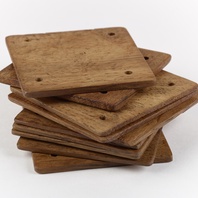
Viking Objects
Reproduction Weaving Tablets
Wooden weaving tablets for creating tablet-woven braids. These are based on examples found in the Oseberg ship burial.
Read More
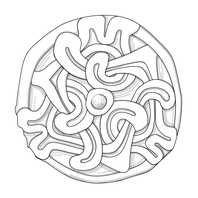
Viking Designs
Drawing of Copper Alloy Disc Brooch
Drawing of a copper alloy, gilded brooch with a zoomorphic design. Brooches were a typical part of female dress. Scandinavian brooches came in a variety of sizes and shapes which included disc, trefoil, lozenge, equal-armed, and oval shapes. The different brooch types served a variety of functions in Scandinavian female dress with oval brooches typically being used as shoulder clasps for apron-type dresses and the rest being used to secure an outer garment to an inner shift. Anglo-Saxon brooches do not match this diversity of form with large disc brooches being typical of ninth century dress styles with smaller ones becoming more popular in the later ninth and tenth centuries. However, since disc brooches were used by both Anglo-Saxon and Scandinavian women they are distinguished by their morphology. Scandinavian brooches were typically domed with a hollow back while Anglo-Saxon brooches were usually flat. Moreover, Anglo-Saxon brooches were worn singly without accompanying accessories.
Read More

Viking Designs
Drawing of Detail from the Southwell Lintel
The lintel above a door in Southwell Minster features the Archangel Michael fighting off a Norse-style ribbon beast. This drawing shows a detail of the ribbon beast. The lintel is probably an eleventh-century grave cover that was recarved and decorated in the twelfth century and placed into a new position.
Read More
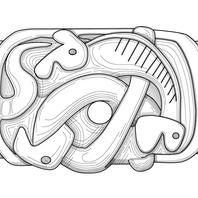
Viking Designs
Drawing of an Urnes-Style Mount
A drawing of a cast copper alloy sword fitting with Urnes-style decoration.
Read More
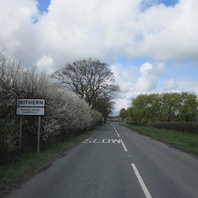
Viking Names
Withern with Stain
The current name combines two originally separate places. Withern shows the influence of Old Norse on an English place-name. Originally, this name was formed from the Old English elements widu ‘wood’ + ærn ‘a house’. However, given the large number of Scandinavian speakers in the area, they pronounced the first element as if it was the cognate Old Norse element viðr, also meaning ‘wood’. The ‘th’ in the modern form preserves this pronunciation difference between the closely-related Old English and Old Norse elements. Stain comes directly from Old Norse steinn ‘stone’ – the place was presumably named after a prominent stone there. Many other place-names in Lincolnshire, like Stainby, Stainfield and Stainton, also contain this word as their first element. Elsewhere in England, such names tend to be spelled ‘Stan-‘, like the very common Stanton, which is the same name but deriving its first element from Old English stān ‘stone’.
Read More
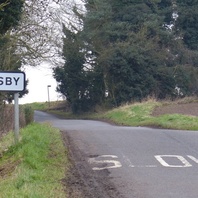
Viking Names
Frisby
Frisby, in the Gartree Hundred of Leicestershire, takes its name from a Scandinavian form of an ethnonym Frisa (gen. pl.) ‘Frisians’ and the Old Norse element by ‘farmstead, village’. This name has a similar construction to Frisby on the Wreake in the East Goscote Hundred of Leicestershire. Traditionally, the place-name has been interpreted as referring to Frisians who took part in the Viking invasions. However, the exact implications of such a name are not yet fully understood and are the subject of ongoing work by Dr Jayne Carroll of the Institute for Name-Studies, University of Nottingham.
